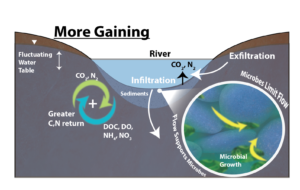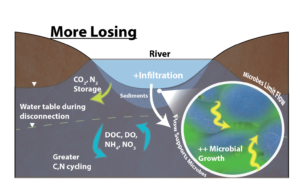In this work, modeling capabilities were advanced to assess the functioning of a hyporheic zone under various climatic conditions, impacted by surface-water groundwater interactions, and feedbacks with microbial biomass.
Results of the study show that while highly losing rivers have greater hyporheic CO2 and N2 production, gaining rivers allowed the greatest fraction of CO2 and N2 production to return to the river.
Summary
River systems are important components of our landscape that help to degrade contaminants, support food webs, and transform organic matter. In this study, a model was developed and tested that could help reveal the role of the riverbed for these ecosystem services. The model was used to explore how different riverbed conditions eventually control the fate of carbon and nitrogen. The results show that carbon and nitrogen transformations and the potential suite of microbial behaviors are dependent on the riverbed sediment structure and the water table conditions in the local groundwater system. The implications of this are that the riverbed sediments and the cumulative effect of water table conditions can control hyporheic processing. Under future river discharge conditions, assuming reduced river flows and siltation of riverbeds, reductions in total hyporheic processing may be observed.
Citation
Newcomer, M. E., Hubbard, S. S., Fleckenstein, J. H., Maier, U., Schmidt, C., Thullner, M., et al. (2018). Influence of hydrological perturbations and riverbed sediment characteristics on hyporheic zone respiration of CO2 and N2. JGR: Biogeosciences, 123, 902–922. DOI: 10.1002/2017JG004090


